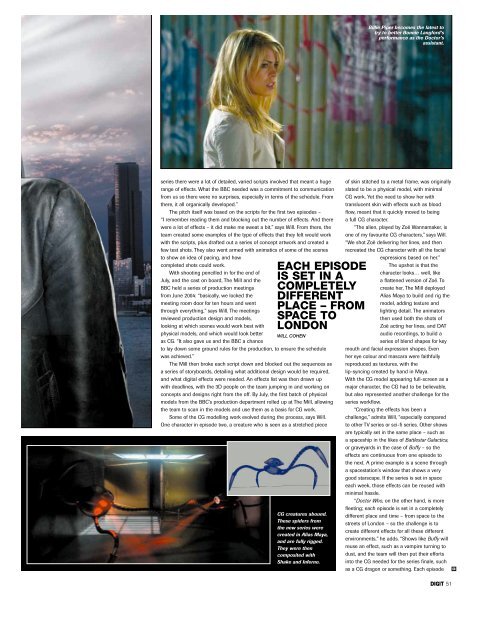Create successful ePaper yourself
Turn your PDF publications into a flip-book with our unique Google optimized e-Paper software.
series there were a lot of detailed, varied scripts involved that meant a huge<br />
range of effects. What the BBC needed was a <strong>com</strong>mitment to <strong>com</strong>munication<br />
from us so there were no surprises, especially in terms of the schedule. From<br />
there, it all organically developed.”<br />
The pitch itself was based on the scripts for the first two episodes –<br />
“I remember reading them and blocking out the number of effects. And there<br />
were a lot of effects – it did make me sweat a bit,” says Will. From there, the<br />
team created some examples of the type of effects that they felt would work<br />
with the scripts, plus drafted out a series of concept artwork and created a<br />
few test shots. They also went armed with animatics of some of the scenes<br />
to show an idea of pacing, and how<br />
<strong>com</strong>pleted shots could work.<br />
With shooting pencilled in for the end of<br />
July, and the cast on board, The Mill and the<br />
BBC held a series of production meetings<br />
from June 20<strong>04</strong>: “basically, we locked the<br />
meeting room door for ten hours and went<br />
through everything,” says Will. The meetings<br />
reviewed production design and models,<br />
looking at which scenes would work best with<br />
physical models, and which would look better<br />
as CG. “It also gave us and the BBC a chance<br />
EACH EPISODE<br />
IS SET IN A<br />
COMPLETELY<br />
DIFFERENT<br />
PLACE – FROM<br />
SPACE TO<br />
LONDON<br />
WILL COHEN<br />
to lay down some ground rules for the production, to ensure the schedule<br />
was achieved.”<br />
The Mill then broke each script down and blocked out the sequences as<br />
a series of storyboards, detailing what additional design would be required,<br />
and what digital effects were needed. An effects list was then drawn up<br />
with deadlines, with the 3D people on the team jumping in and working on<br />
concepts and designs right from the off. By July, the first batch of physical<br />
models from the BBC’s production department rolled up at The Mill, allowing<br />
the team to scan in the models and use them as a basis for CG work.<br />
Some of the CG modelling work evolved during the process, says Will.<br />
One character in episode two, a creature who is seen as a stretched piece<br />
CG creatures abound.<br />
These spiders from<br />
the new series were<br />
created in Alias Maya,<br />
and are fully rigged.<br />
They were then<br />
<strong>com</strong>posited with<br />
Shake and Inferno.<br />
Billie Piper be<strong>com</strong>es the latest to<br />
try to better Bonnie Langford’s<br />
performance as the Doctor’s<br />
assistant.<br />
of skin stitched to a metal frame, was originally<br />
slated to be a physical model, with minimal<br />
CG work. Yet the need to show her with<br />
translucent skin with effects such as blood<br />
flow, meant that it quickly moved to being<br />
a full CG character.<br />
“The alien, played by Zoë Wannamaker, is<br />
one of my favourite CG characters,” says Will.<br />
“We shot Zoë delivering her lines, and then<br />
recreated the CG character with all the facial<br />
expressions based on her.”<br />
The upshot is that the<br />
character looks… well, like<br />
a flattened version of Zoë. To<br />
create her, The Mill deployed<br />
Alias Maya to build and rig the<br />
model, adding texture and<br />
lighting detail. The animators<br />
then used both the shots of<br />
Zoë acting her lines, and DAT<br />
audio recordings, to build a<br />
series of blend shapes for key<br />
mouth and facial expression shapes. Even<br />
her eye colour and mascara were faithfully<br />
reproduced as textures, with the<br />
lip-syncing created by hand in Maya.<br />
With the CG model appearing full-screen as a<br />
major character, the CG had to be believable,<br />
but also represented another challenge for the<br />
series workflow.<br />
“Creating the effects has been a<br />
challenge,” admits Will, “especially <strong>com</strong>pared<br />
to other TV series or sci-fi series. Other shows<br />
are typically set in the same place – such as<br />
a spaceship in the likes of Battlestar Galactica,<br />
or graveyards in the case of Buffy – so the<br />
effects are continuous from one episode to<br />
the next. A prime example is a scene through<br />
a spacestation’s window that shows a very<br />
good starscape. If the series is set in space<br />
each week, those effects can be reused with<br />
minimal hassle.<br />
“Doctor Who, on the other hand, is more<br />
fleeting; each episode is set in a <strong>com</strong>pletely<br />
different place and time – from space to the<br />
streets of London – so the challenge is to<br />
create different effects for all these different<br />
environments,” he adds. “Shows like Buffy will<br />
reuse an effect, such as a vampire turning to<br />
dust, and the team will then put their efforts<br />
into the CG needed for the series finale, such<br />
as a CG dragon or something. Each episode<br />
d 51


